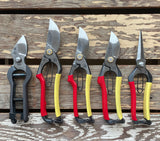Unlike secateurs, snips are only meant for very light snipping work. The long skinny blades allow you to get into tight spaces and make precise cuts without leaving stubs.
Especially great for deadheading, cut flowers, harvesting veggies, and cutting lengths of twine for staking. In Japan, they are used for needling pines. Not suitable for pruning woody material, cutting wire or opening paint cans!
These are definitely a step up from inexpensive flower snips - I prefer the lock on these which is so much easier to use than flimsy leather or plastic clasps. The higher quality steel sharpens and holds an edge better, and the sturdier construction means that I'll have them for a lifetime.
The locking mechanism on Japanese secateurs and snips is the feature that sets them apart for me - and this is especially important in a pair of snips. I find less expensive models fiddly to close and lock; these are much more efficient and, like the Tobisho secateurs and clippers, can be locked with one hand.
The red and yellow handles are easy to find if you put them down in the garden. But don't! You'll want to keep these safe and sound in your holster.
Tobisho pruning tools are the crème de la crème in the Japanese gardening world. They are made in a small family-run factory in Yamagata, an area famous for the quality of its steel. All their tools are drop forged, with great attention to detail - they have incredible weight and balance and are such a pleasure to use!
Tobisho recommends sharpening with the Niwaki sharpening stones.
View the entire Tobisho collection here.
Product Details
- KA-70 carbon steel
- blade length: 2.5" (60mm)
- total length: 8" (200mm)
- max cut: Ø5mm
- weight: 0.5lbs (235g)
- made in Japan
- comes with spare spring



